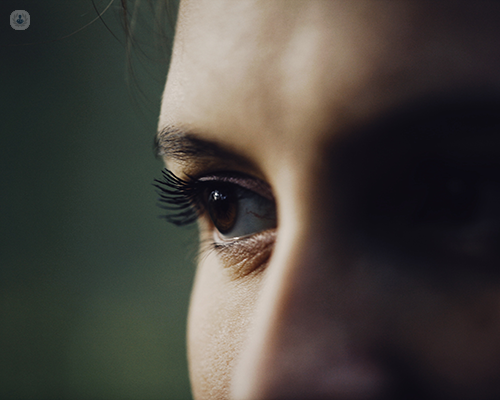What causes a macular hole?
Written in association with:A macular hole is an eye condition that develops in the macula (the part of the retina that is key to central vision) and which mostly affects people who are over 60 years of age.
Here, Mr Stephen Lash, distinguished consultant ophthalmic surgeon, provides an expert insight into the condition, explaining what causes a macular hole and how is it surgically treated, among other important points.

What is a macular hole? What are its symptoms?
The macula is the very sensitive part at the centre of the retina, which is the light-sensitive lining of our eyes. It is the only part of the eye that can see detail; if you look at a clock on a wall and then look to the side of that same clock, the numbers become blurred.
Most people have heard of the macula in terms of ‘macular degeneration’, but a macular hole is not macular degeneration. A hole in the macula will cause vision to become very blurred, and patients will often describe a form of distortion whereby people’s heads appear squashed on their shoulders. Early warning signs are distorted and reduced vision.
What causes a macular hole?
A macular hole is caused by the jelly of the eye pulling at the very centre, which lifts the retina up into a tent and then breaks away to form a ‘tin-opener’ type appearance. With time, the flap separates and the hole increases in size. Small macular holes, in particular, enlarge quickly.
Treatment for macular holes has been available since 1993, but technology has improved since then and success rates are now very high at over 90 per cent – for small macular holes, especially.
After the closure of a macular hole, vision will improve around four lines down the optician’s test chart on average, and will continue to do so up to a year after surgery.
What does macular hole surgery involve? What is the recovery period like after the procedure? Can I drive if I have a macular hole?
Macular hole surgery involves removing the jelly of the eye - and given that a macular hole tends to occur in people over 60 years of age - we also tend to remove early cataract at the same time which if not done, can develop within months of the macular hole surgery.
The surgical procedure is performed under local anaesthesia, but patients see and feel nothing. The intervention is more comfortable than people might first imagine.
Importantly, a gas bubble is placed in the eye to help with the closure of the macular hole. Patients cannot see or fly with this gas in the eye. I personally use a two-week gas most of the time, because it gets smaller, rounder and lower in only two weeks. I do not posture after surgery, but instead ask patients to avoid lying flat on their back for one week.
Macular hole surgery is comfortable and there is no pain afterwards, but drops must be used for one month after surgery. It is also best to have a couple of weeks off work to allow the gas to absorb slowly.
Driving can restart when the bubble has disappeared.
What happens if a macular hole is left untreated?
Without surgery, a macular hole gets bigger and harder to treat. Even if the macular hole is treated successfully later on, visual recovery is more limited, so the sooner the better.
If you require expert treatment for a macular hole, don’t hesitate to book an appointment with Mr Stephen Lash via his Top Doctors profile today.


